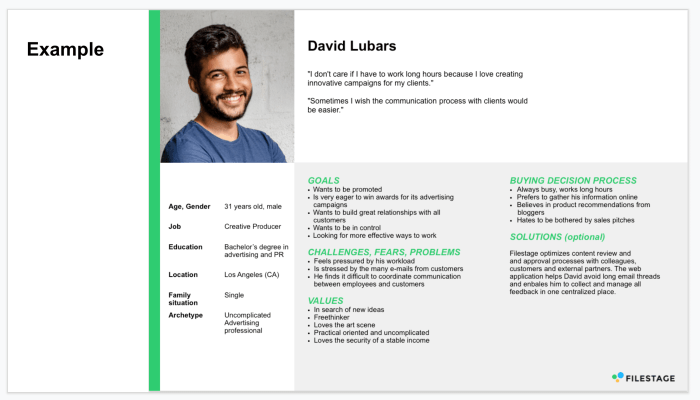Creating a Marketing Persona takes center stage, inviting you into a world where understanding your audience is key to successful marketing. Get ready to dive deep into the realm of personas and strategies that drive engagement and growth.
Understanding Marketing Persona: Creating A Marketing Persona
Marketing persona is a fictional representation of an ideal customer based on market research and real data. It helps businesses understand their target audience better and tailor their marketing strategies to meet their needs effectively.
Creating marketing personas is crucial for businesses to personalize their marketing efforts, improve customer engagement, and increase conversions. By identifying specific characteristics, behaviors, and preferences of their target audience, businesses can create targeted campaigns that resonate with their customers.
Importance of Marketing Personas
- Allows businesses to understand their customers’ needs and preferences.
- Helps in creating personalized and relevant marketing messages.
- Enables businesses to target the right audience effectively.
- Improves customer acquisition and retention rates.
Examples of Marketing Personas in Action
For example, a clothing brand may create a marketing persona named “Fashionista Fiona,” who is a young professional with a passion for trendy fashion. By targeting this persona, the brand can create marketing campaigns showcasing the latest fashion trends that appeal to Fiona’s style preferences.
Alternatively, a fitness center may develop a marketing persona called “Fit Mike,” who is a health-conscious individual looking to improve his overall fitness. By understanding Mike’s goals and challenges, the fitness center can tailor its services and promotions to meet his specific needs and motivate him to join their gym.
Research and Data Collection

When it comes to creating marketing personas, conducting research and gathering data is crucial to truly understand your target audience. By analyzing demographics, behavior patterns, and interests, you can tailor your marketing strategies to effectively reach and engage with your ideal customers.
Methods for Conducting Research
- Surveys: Sending out surveys to your current customers or target audience can provide valuable insights into their preferences, needs, and behaviors.
- Interviews: Conducting one-on-one interviews with customers can help you dive deeper into their motivations and pain points.
- Social Media Listening: Monitoring social media platforms for conversations related to your industry or brand can offer real-time feedback and trends.
- Website Analytics: Analyzing data from your website, such as page views, bounce rates, and conversion rates, can help you understand how visitors interact with your content.
Importance of Analyzing Demographics, Behavior Patterns, and Interests, Creating a Marketing Persona
Analyzing demographics, behavior patterns, and interests is essential for creating accurate and detailed marketing personas. Demographics such as age, gender, income, and location provide a basic understanding of who your audience is. Behavior patterns reveal how customers interact with your brand, while interests show what they are passionate about. By analyzing these factors, you can create personalized marketing campaigns that resonate with your target audience.
Tools and Techniques for Data Collection
- Google Analytics: This tool provides in-depth insights into website traffic, user behavior, and conversion rates.
- Social Media Analytics: Platforms like Facebook Insights, Twitter Analytics, and Instagram Insights offer data on audience demographics, engagement, and reach.
- Customer Relationship Management (CRM) Systems: CRM systems like Salesforce or HubSpot can help you track customer interactions and preferences.
- Online Surveys: Tools like SurveyMonkey or Google Forms make it easy to create and distribute surveys to collect valuable feedback from your audience.
Developing Marketing Persona

Creating a detailed marketing persona involves several key steps to ensure a deep understanding of your target audience. By segmenting the audience based on collected data and personalizing the marketing personas, you can enhance engagement and tailor your marketing strategies effectively.
Segmenting the Target Audience
- Utilize demographics such as age, gender, location, income level, and education to segment your audience.
- Consider psychographics like interests, values, attitudes, and lifestyle choices to further refine your target persona.
- Analyze behavioral data such as purchase history, online activity, and engagement with your brand to understand consumer behavior.
Personalizing Marketing Personas
- Use the collected data to create detailed profiles that reflect the characteristics and preferences of your target audience.
- Include relevant details such as hobbies, challenges, goals, and pain points to make the personas more relatable.
- Ensure each persona has a unique name, background story, and visual representation to bring them to life.
- Tailor your marketing messages, content, and offers to resonate with each persona, addressing their specific needs and motivations.
Implementing Marketing Persona
Marketing personas play a crucial role in crafting targeted marketing campaigns that resonate with specific audience segments. By understanding the needs, preferences, and behaviors of different personas, marketers can tailor their messaging and strategies to effectively reach and engage with their target audience.
Crafting Targeted Marketing Campaigns
- Personalizing messaging: Marketers can use marketing personas to create personalized content and messaging that speaks directly to the needs and interests of different audience segments.
- Choosing the right channels: Understanding the preferred communication channels of each persona helps in selecting the most effective platforms to reach and engage with them.
- Optimizing ad targeting: By aligning marketing personas with advertising targeting options, marketers can ensure that their ads are shown to the right people at the right time.
Role in Content Creation and Messaging
- Creating relevant content: Marketing personas guide content creation by providing insights into the topics, formats, and tone that resonate with different audience segments.
- Developing compelling messaging: Tailoring messaging to address the pain points and aspirations of each persona helps in creating more impactful and relevant communication.
- Enhancing brand storytelling: Marketing personas help in shaping brand narratives that connect with the values and preferences of target audiences, leading to stronger brand affinity.
Examples of Successful Marketing Strategies
- Apple’s “Get a Mac” Campaign: Apple targeted different personas (Mac users, PC users, tech enthusiasts) with humorous ads that highlighted the benefits of using a Mac over a PC, effectively resonating with each audience segment.
- Dove’s “Real Beauty” Campaign: Dove created marketing personas based on women’s diverse perceptions of beauty and developed content that celebrated real beauty, leading to a positive emotional response from their target audience.
- Coca-Cola’s “Share a Coke” Campaign: Coca-Cola personalized their packaging with popular names and phrases, resonating with consumers who were seeking personalized and shareable experiences, resulting in increased brand engagement.